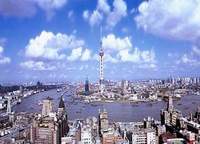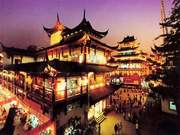|
Shanghai
Shanghai, a world-famous
metropolis, is the largest city of China with a status
equivalent to a province. It lies on Huangpu River, in the
Yangtze delta, covering an area of 6340 square km. It has an
oceanic and monsoon climate in the subtropical zone, with an
annual average temperature of 15.5 degrees Centigrade, and
rainfall of 1,120 millimeters. Shanghai is neither cold in
winter, nor very hot in summer.
 Shanghai is endowed with favorable
geographical and natural conditions, and a long history of
development. It has a well-developed commodity economy and
comparatively high scientific and technological level. In
recent years, it has made rapid progress in finance and
banking service, and stands as one of the main financial
centers in China. The Pudong Development Area in Shanghai is
an important special economic zone in China. The level of the
new area's industry, commerce, finance, trade, post and
telecommunications stands at the forefront in
China. Shanghai is endowed with favorable
geographical and natural conditions, and a long history of
development. It has a well-developed commodity economy and
comparatively high scientific and technological level. In
recent years, it has made rapid progress in finance and
banking service, and stands as one of the main financial
centers in China. The Pudong Development Area in Shanghai is
an important special economic zone in China. The level of the
new area's industry, commerce, finance, trade, post and
telecommunications stands at the forefront in
China.
Shanghai is an important
hub of communications. It has an easy access to the outside
world by all means of transport: ocean, offshore and inland
water shipping, high way and railroad transport, air flights
etc. As the biggest seaport in China, the port of Shanghai has
trade links with ports of over 100 countries and
regions.
Efforts are being made to
develop Shanghai into a modern international economic,
financial and trade center.
 Yuyuan Garden Yuyuan Garden
Yuyuan Garden is located in
Chenghuangmiao (City God Temple) in urban Shanghai. Built in
1559, it occupies only two hectares yet offers 40 scenic
attractions. Thanks to its intricate design, it's complete
with pavilions, lakes, bridges and rocks.
City God Temple
The City God Temple was a
Taoist Temple. According to Taoism cities should be guarded by
city gods. Shanghai had its first City God Temple built in the
Song Dynasty (960-1279). Today's City God Temple Bazaar is
composed of specialty stores selling traditional Chinese arts
and crafts, medicine and souvenirs. Over a hundred small
stores stand side by side, beautifully laid with a large
collection of commodities, each with its own unique feature
and alive with shoppers, keeping the style of traditional
Chinese town streets.
 Yufo (Jade Buddha)
Temple Yufo (Jade Buddha)
Temple
The Jade Buddha Temple was
built in 1882, and covers 8,000 square meters. The temple got
its name from the two jade statues of Sakyamuni, one seated
and one reclining, both brought from Myanmar.
The Huangpu River
The 110-kilometer-long
Huangpu River flows through Shanghai.
Shanghai Museum
The museum collects bronze
ware from the Shang and Zhou dynasties (16th to 3rd century
B.C.), pottery, porcelain, calligraphy and paintings. It also
boasts collections of sculptures, seals, currency and arts
& crafts of various dynasties. |
